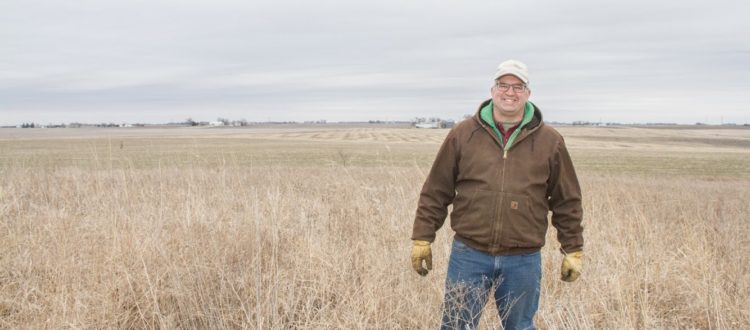Restoring Family Farm Diversity with Organic Crops, Prairie, and Wetlands

Aaron Lehman is rediversifying the family farm with an extended crop rotation and native habitat restoration. Here, he stands in reconstructed prairie with organic fields in the background.
Since the Lehman family purchased their farm in 1869, there has been a dramatic change in the landscape near Alleman, Iowa. The rich, flat fields in the center of Iowa once supported dairy and beef cattle, chickens, sheep, pigs, and work horses, and the forages (such as alfalfa), oats, wheat, and corn that fed them. In the mid-1990s when Aaron returned to farm with his father, Phil, the family’s own fields mirrored the surrounding crop landscape with a simple rotation of corn and soybeans.

Red clover in Aaron’s organic rotation provides nitrogen for the following corn crop, and improves the health of the soil.
As Aaron explains, crop diversity was pared down through the latter half of the 20th century largely for economic reasons related to concentration in the marketplace. In the mid-2000s, he and his dad decided to buck the trend of the two-crop system and began to explore certified organic production as a way to re-diversify the land and improve sustainability, while increasing net revenue.
Organic systems require longer rotations in lieu of insecticides and fungicides. Today, Aaron grows diverse and densely rooted plants such as oats, alfalfa, and cover crops of red clover, cereal rye, and mustard to improve the health of the soil. As a result, cash crops are able to uptake more nutrients and rainwater, and defend themselves against diseases and insect pests. Another benefit of crop diversity, notes Aaron, “We’re breaking up the weed and insect cycles, and are hopefully providing more of a good environment for beneficial insects.”

Diverse cover crops capture nutrients outside of the growing season, and build up soil organic matter.
These days, Aaron is looking outside of the crop fields to provide even higher quality habitat for beneficial insects. In the 1980s, a steep knoll that Aaron remembers cultivating up and down as a youth was enrolled in the Conservation Reserve Program (CRP). Back then, the standard practice was to seed CRP with non-native smooth brome grass for erosion prevention, but around five years ago, Aaron transformed it into a flower-filled habitat for beneficial insects and other wildlife by replanting it with diverse, native prairie.
Always looking for new ways to improve the sustainability and profitability of his farm, Aaron connected with Luke at Prudenterra. Aaron had some new practices on his mind, and in 2015, he and Luke went on a Land Walk. As they crossed the landscape, they analyzed the strengths and weaknesses of different areas and practices, and how they could be modified for greater ecological and financial gains. With yield maps in hand, they were able to identify some areas that were prone to frequent flooding, and as a result, not as profitable. Aaron noted, “We talked about a whole wide range of topics about the farm. What it led to eventually was us putting in a plan for pollinator areas and wetland areas. That is what directly led out of it, but the conversation is still not done.” Looking to the future, Aaron is still thinking about other topics they discussed, such as reinvigorating the farmstead windbreaks.

The Lehmans’ restored wetland depression will soon be seeded with native prairie.
Last fall, Prudenterra ‘broke ground’ on the wetland reconstruction. Earthmoving equipment restored a depression in the landscape to enable it to hold and filter more water, as it would have prior to the arrival of the plow. High quality local-ecotype prairie seed will soon be spread over the wetlands and neighboring pollinator habitat areas. Not only will these areas provide phenomenal habitat for the insects that are beneficial to the organic crop fields, but taking them out of production will save money on inputs that would otherwise be misdirected at poorly-yielding crops. In addition, the Conservation Reserve Program (CRP) will cover a portion of the cost of construction and provide an annual land rental payment.
For Aaron, rediversifying the family farm has happened gradually, as they transition the land 40 acres at a time from conventional to organic, and begin restoring habitat, starting with the most critical areas. “Short-term economics sometimes has to rule the day, but in the long-run you have to do what will be good for you and your family for that farm for generations to come. Finding a balance between those things is important, and the exciting thing is that I think the practices we are putting into place will make us a more sustainable farm financially as well as ecologically.”

